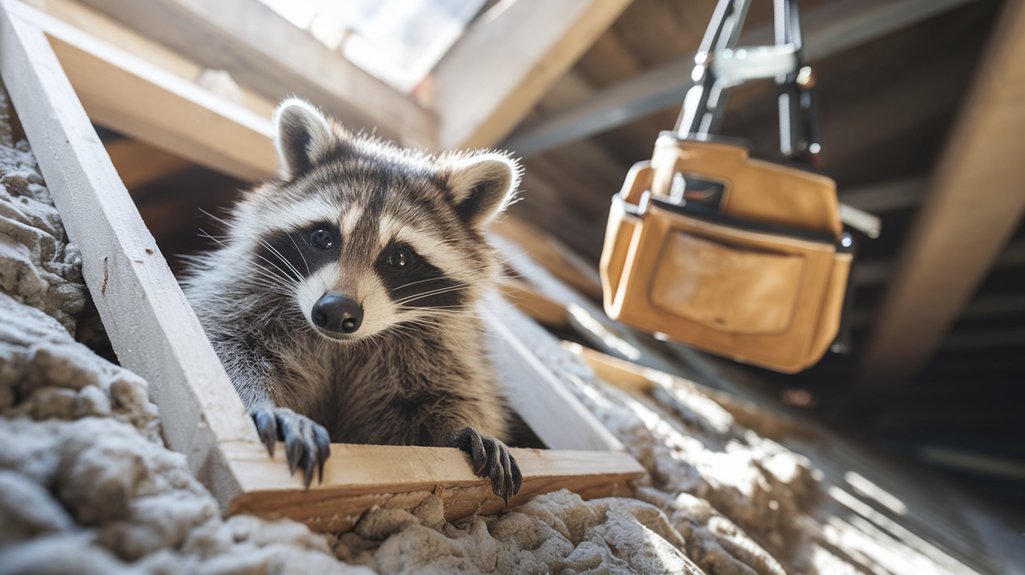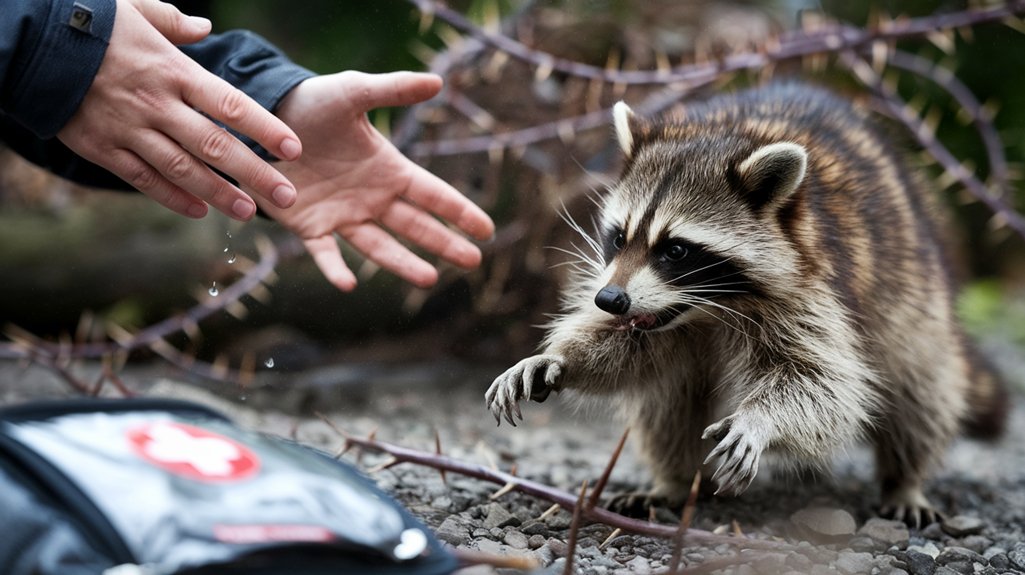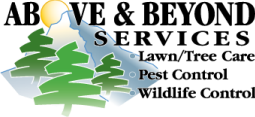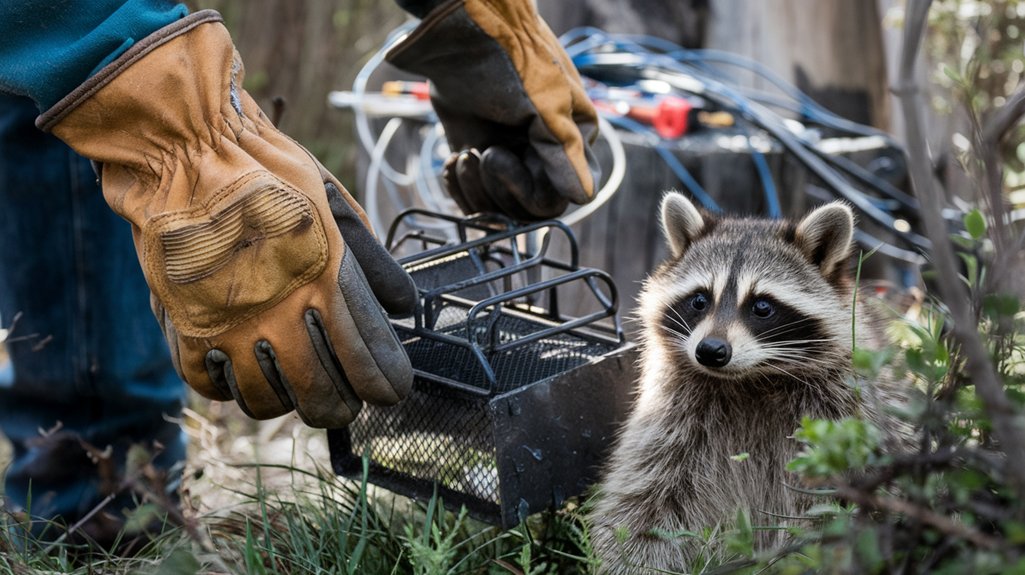When you encounter wildlife in your home, it might be tempting to handle the situation yourself. However, tackling DIY wildlife removal can lead to unexpected dangers. From injuries due to bites and scratches to the risk of contracting diseases, the hazards can escalate quickly. Plus, there are legal aspects to consider that could complicate matters further. Before you take any action, it’s important to understand what’s at stake.
Understanding the Risks of DIY Wildlife Removal

While tackling wildlife removal on your own might seem like a cost-effective solution, it also comes with significant risks. You need to conduct a thorough risk assessment before attempting any removal, as understanding wildlife behavior is crucial.
Ignoring these factors can lead to dangerous encounters, such as bites or disease transmission. Wildlife can be unpredictable, and what seems like a harmless animal can quickly become aggressive when threatened.
Without proper training, you might misinterpret their actions, putting yourself and others in danger. Additionally, improper removal methods can cause more harm than good, leading to legal issues or property damage.
It’s essential to weigh these risks against any potential savings before deciding to go the DIY route.
Wildlife Removal experts protect you and animals. Learn wildlife tips from Colorado Parks and Wildlife.
Common Wildlife Encounters in Urban Areas

Have you ever wondered what wildlife you might encounter in your urban neighborhood?
Urban wildlife is more common than you think, and you might be surprised by the variety of species that share your space.
Here are some of the most frequent encounters:
- Raccoons rummaging through trash
- Squirrels darting across power lines
- Foxes prowling through parks
- Possums scavenging at night
- Birds nesting in eaves
These common species adapt well to city life, often finding food and shelter in unexpected places.
While they can be fascinating to observe, it’s important to remember that interacting with urban wildlife can lead to issues.
If you encounter these animals and need help, it’s best to call a professional for safe removal.
Potential Injuries From Handling Wildlife

When you attempt to handle wildlife, you put yourself at risk for various injuries that can be both painful and dangerous. Bites and scratches from wild animals can lead to serious infections and transmit wildlife diseases like rabies or hantavirus.
Even seemingly harmless creatures can cause harm if provoked. It’s crucial to understand that injury prevention starts with recognizing your limits. Without proper training and equipment, you could easily find yourself in a perilous situation.
Professionals know how to handle wildlife safely, reducing the risk of injury to both you and the animal. Instead of taking unnecessary risks, call an expert who can manage the situation effectively and keep you safe from potential harm.
Legal Implications of DIY Wildlife Removal
Although you might think handling wildlife on your own is a simple solution, there are significant legal implications to consider.
Ignoring wildlife regulations can lead to serious legal consequences. Here’s what you need to keep in mind:
- Permits: Many states require permits for wildlife removal.
- Protected Species: Some animals are protected by law; harming them can result in fines.
- Relocation Laws: Relocating wildlife often violates regulations and can result in penalties.
- Liability: If you injure an animal, you may be held legally responsible.
- Reporting Requirements: Certain incidents must be reported to local authorities.
Understanding these factors helps you avoid unnecessary legal troubles.
It’s always best to call a professional who knows the laws and can safely handle the situation.
The Importance of Proper Identification
Proper identification of wildlife is crucial before attempting any removal, as misidentifying an animal can lead to ineffective or dangerous actions. You need to understand species differentiation to ensure you’re dealing with the right animal.
Different species have unique behaviors, risks, and legal protections. Without proper identification, you might inadvertently confront a more aggressive animal or fail to address the real issue.
Additionally, habitat awareness is vital; knowing where an animal typically resides helps you understand its habits and potential escape routes. A professional has the expertise to identify the species accurately and assess the situation.
Ethical Considerations for Animal Treatment
While you might feel compelled to remove wildlife from your property, it’s essential to consider the ethical implications of your actions.
Humane treatment of animals isn’t just a moral obligation; it also impacts local ecosystems. When dealing with wildlife, keep these ethical considerations in mind:
- Use ethical trapping methods that minimize stress.
- Avoid relocating animals, as it can disrupt their social structures.
- Ensure any removal plans comply with local wildlife laws.
- Prioritize non-lethal solutions whenever possible.
- Consult professionals who specialize in humane wildlife management.
The Benefits of Professional Wildlife Removal Services
When you face a wildlife issue on your property, opting for professional removal services can save you time and reduce stress.
Professionals use expert techniques to effectively identify, capture, and relocate animals without causing harm. They understand animal behavior and can address the issue safely, preventing further complications.
Additionally, these services focus on humane solutions, ensuring that animals are treated with care throughout the process. You won’t have to worry about injuries or legal ramifications that can arise from DIY attempts.
Ultimately, hiring experts allows you to regain peace of mind, knowing the situation is handled properly and ethically. It’s a smart investment in your property’s safety and the well-being of the wildlife involved.
Prevention Strategies for Wildlife Encroachment
To effectively prevent wildlife encroachment on your property, it’s important to implement proactive strategies.
By making some simple habitat modifications and using exclusion techniques, you can significantly reduce the chances of unwanted wildlife visits.
Here are some effective strategies to consider:
- Seal any gaps or holes in your home’s exterior.
- Install durable screens on vents and chimneys.
- Keep food and trash securely stored indoors.
- Trim overhanging branches that provide access to roofs.
- Create a barrier around gardens to deter animals.
When to Seek Help From Wildlife Experts
Recognizing the signs of wildlife problems early can save you time and trouble, so it’s crucial to know when to call in professionals. If you notice unusual wildlife behavior, like persistent noises in your attic or signs of nesting, it’s time to act. You should also seek help if you encounter injured animals or potential rabies risks. Emergency response is vital in these situations to ensure safety for both you and the wildlife.
| Signs of Wildlife Issues | When to Call Pros | Why It’s Important |
|---|---|---|
| Noises at night | Immediately | Prevent damage |
| Nests in odd places | Within 24 hours | Ensure safety |
| Injured animals | Right away | Protect wildlife |
| Disease signs | ASAP | Avoid health risks |
Frequently Asked Questions
What Tools Do Professionals Use for Wildlife Removal?
Professionals use specialized removal equipment like traps, nets, and protective gear. They employ effective trapping techniques to safely capture and relocate wildlife, ensuring both your safety and the animals’ well-being during the process.
How Much Does Professional Wildlife Removal Typically Cost?
The cost of professional wildlife removal typically ranges from $100 to $500. Factors like the type of animal, location, and service comparisons influence pricing, so you should always get multiple quotes to find the best deal.
Are There Any Guarantees With Professional Wildlife Removal Services?
When considering professional wildlife removal, you’ll find various guarantee options. Reputable services often offer service reliability, ensuring your home remains pest-free. Always ask about guarantees to ensure you’re making a confident choice for your needs.
What Happens to the Animals After Removal?
After removal, animals may undergo rehabilitation options to ensure their well-being. Relocation policies vary, but professionals usually follow guidelines to place them in suitable habitats, minimizing stress and promoting their chances of survival.
Can I Perform Wildlife Removal During Certain Seasons?
You can perform wildlife removal during certain seasons, but you must consider seasonal regulations and animal behavior. Some species may be protected during breeding seasons, making it crucial to check local laws before proceeding.
In conclusion, tackling wildlife removal on your own can lead to serious risks, from injuries to legal troubles. You might think you can handle it, but the unpredictable nature of animals makes it dangerous. By calling a professional, you ensure a safe, humane, and effective solution that protects both you and the wildlife. Don’t take unnecessary chances—reach out to experts who can manage the situation responsibly and help prevent future encounters.
Contact Us
Wildlife Removal with Above & Beyond Services ensures safe, humane solutions in Denver. Call (720) 806-6378 or visit Above & Beyond Services for free quotes on wildlife control, pest management, and more.
Key Takeaways
- Handling wildlife can lead to bites and scratches, increasing the risk of serious infections and disease transmission.
- Unpredictable animal behavior may result in aggressive encounters, posing safety risks to untrained individuals.
- Legal regulations often require permits for wildlife removal, and harming protected species can lead to fines.
- Professionals employ humane techniques for safe capture and relocation, reducing stress for both the animal and the homeowner.
- Hiring experts saves time and minimizes the risk of injuries or legal complications associated with DIY attempts.




